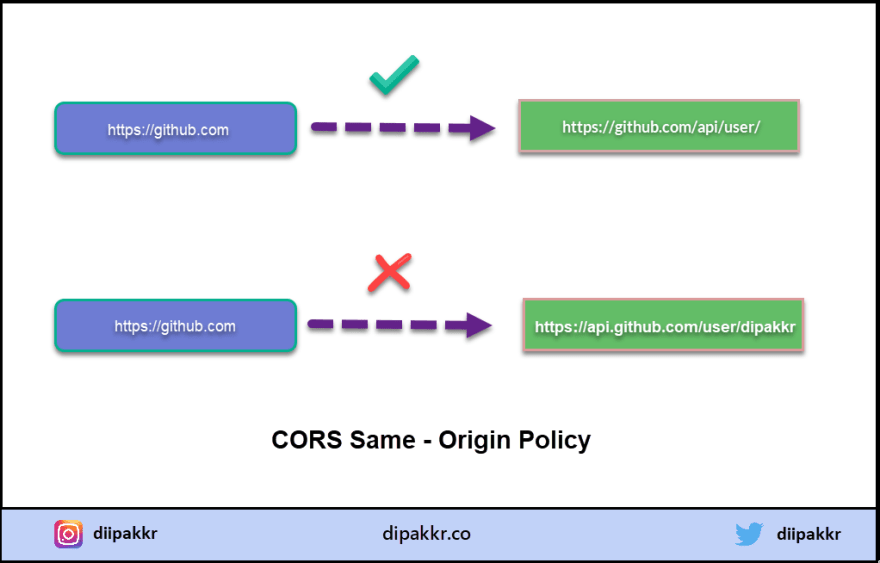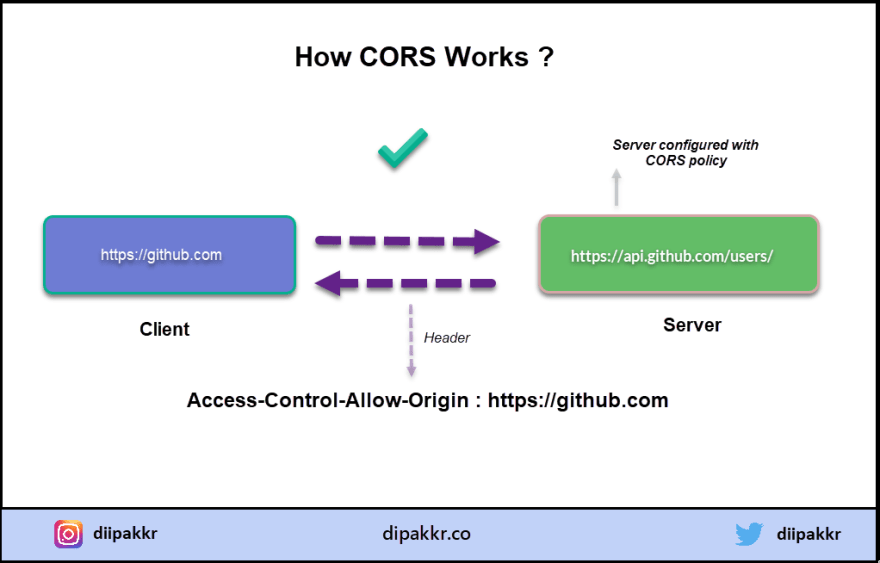How CORS (Cross-Origin Resource Sharing) Works?

Deepak Kumar
Posted on December 17, 2019
If you are a web developer, you must have seen the 'CORS' error appearing often on your screen when you try to call the API. But, Why does it happen?
Well, For security reasons, browsers restrict cross-origin HTTP requests initiated from scripts. For example, if you want to access your API hosted at https://api.github.com from your client-side frontend application which is hosted at https://example.com. The browser will not allow this request to complete.
You only need to think about CORS when :
- API accessed by the browser.
- API is hosted on a separate domain.
So, why does it happens?
The browsers enforce a security feature called Same Origin Policy. According to Same Origin Policy, the Same Origin calls are allowed and Different Origin calls are not allowed.
Uhh !! What is this Same Origin, Different Origin? Let's see this more in detail. Browsers define the Origin as a combination of Scheme, Host, and Port.
-
Scheme name — It is the protocol to be used to access the resource on the Internet. The scheme names followed by the three characters
://.The most commonly used protocols arehttp://,https://,ftp://, andmailto://.
-
Hostname — It is the address of the host where the resource is located. A hostname is a domain name assigned to a host computer. This is usually a combination of the host's local name with its parent domain's name. For example,
www.dev.toconsists of the host's machine namewwwand the domain namedev.to
- Port Number — Port is a communication endpoint where your application run. For more information about Port Number. Check out this [Link](https://en.wikipedia.org/wiki/Port_(computer_networking).
If these three combinations of Scheme, Hostname, and Port are same then the browser identifies it as the Same Origin. And, the request gets complete.
So, Does it means that it is impossible to make
Cross-Origin HTTP request??
The answer is NO.
That's where the CORS comes into picture, Cross-Origin Resource Sharing mechanism.
How CORS Works
CORS allows the server to explicitly whitelist certain origin and help to bypass the same-origin policy.
If your server is configured for CORS, it will return an extra header with "Access-Control-Allow-Origin" on each response.
For example, if my API server hosted at https://api.dipakkr.com/users is CORS configured and I am making a request from my client application https://github.com to fetch some data. The response will have this header.
Access-Control-Allow-Origin: https://github.com
CORS Preflight Request
Preflighted requests first send an HTTP request by the OPTIONS method to the resource on the other domain, to determine if the actual request is safe to send or not.
You can read more about CORS Preflight request at MDN or check out this video by Akshay Saini.
How to Enable CORS
For enabling CORS on your server application. You need two things.
First, you need to determine the origins of whitelist.
Second, you have to add the CORS middleware to the server.
Here, I am explaining to you the steps to configure CORS on your NodeJS server.
First install the cors npm package from this link.
npm install cors
Then go to your server application and add the below code.
// require the cors package
var cors = require('cors');
// enables cors
app.use(
cors({
origin: "*",
methods: "GET,HEAD,PUT,PATCH,POST,DELETE",
preflightContinue: false
})
);
Here you can see I am using origin: "*" which means any domain can access this application.
Please note that it is dangerous to put
origin:"*"in a production application and you should never do that.
To know more about CORS, please visit MDN. It's a great place for web developers.
If you read till last, don't forget to give your feedback in the comments. Getting feedback helps me improve.
I write about new stuffs almost daily. You can follow me on Twitter | Instagram
Subscribe to my email newsletter and stay updated!
If you liked the post, give some ❤️!! Cheers

Posted on December 17, 2019
Join Our Newsletter. No Spam, Only the good stuff.
Sign up to receive the latest update from our blog.






